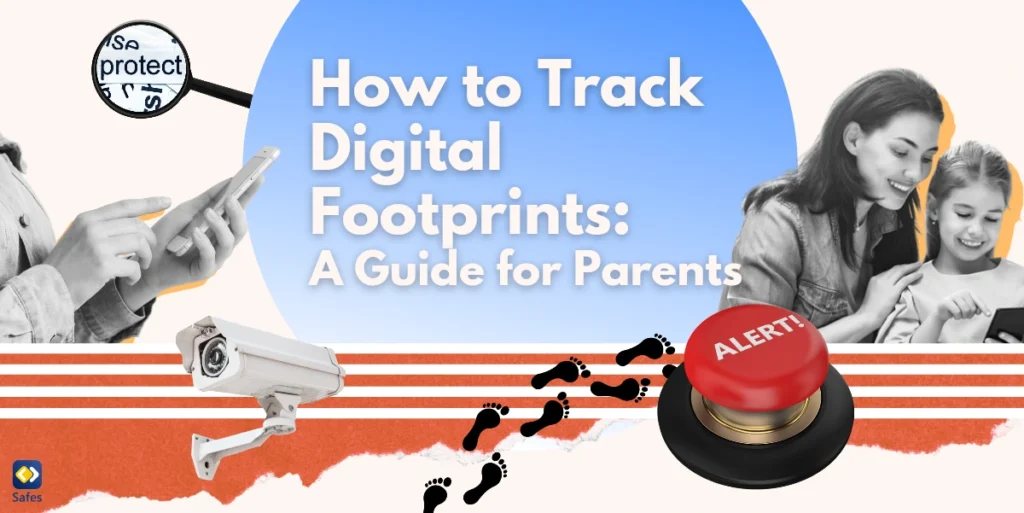In today’s interconnected world, everyone leaves behind a digital footprint—the trail of data we generate when using the internet. For parents monitoring children’s online activities or individuals aiming to protect their privacy, understanding and tracking digital footprints is critical. This article explores how to track digital footprints online, tools like digital footprint tracking software, and the best strategies to stay secure while managing your online presence.
Download and Start Your Free Trial of the Safes Parental Control App
What Is a Digital Footprint?
A digital footprint’s definition refers to the data you leave behind while engaging online, including posts, messages, websites visited, and transactions. These footprints are classified as:
- Active footprints: Information you deliberately share, such as social media posts.
- Passive footprints: Data collected without your knowledge, like browsing habits or location tracking by websites.
Understanding your digital footprint is key to managing privacy, reputation, and online safety.
Why Track Digital Footprints?
- Protect Personal Privacy: Awareness of your footprint helps minimize the risk of identity theft and online scams.
- Manage Reputation: Social media posts, comments, and even old emails can resurface unexpectedly. Tracking helps you clean up inappropriate or outdated content.
- Parental Monitoring: Parents can monitor children’s footprints to ensure safe online behavior.
- Prevent Cyberbullying: Understanding and tracking online activities can help address bullying or malicious interactions early.
How Can You Track a Digital Footprint?
Tracking a digital footprint involves reviewing data trails, analyzing the online presence, and using specialized tools. Here are methods to help:
1. Search Yourself Online
The simplest way is to Google your name or username and analyze what’s publicly visible. Use variations, like nicknames, to see what information pops up. This manual search can reveal active and passive traces of your online activity.
2. Check Social Media Accounts
Audit social media profiles for privacy settings. Review old posts, comments, or photos that might still be public.
3. Use Digital Footprint Tracking Software
Several digital footprint tracking software solutions are available to monitor and manage online presence. These tools scan for mentions of your name, email, or personal data across websites, databases, and social media. Popular tools include:
- Google Alerts: Notifies you whenever your name or specific keywords are mentioned online.
- BrandYourself: Helps you clean up your online reputation and track digital footprint examples across platforms.
- DeleteMe: Removes personal data from public records and websites.
4. Monitor Children’s Footprints
Parents can use parental control apps like Safes Family to track their children’s online activities, ensuring they leave behind safe and appropriate footprints.
Best Digital Footprint Checkers
Here’s a list of the best digital footprint checkers to help track and manage footprints effectively:
- PrivacyDuck: Focuses on removing personal data from people-search websites.
- Spokeo: Allows you to track social media profiles, posts, and public data.
- Surfshark Alert: Monitors leaked personal information, such as passwords or accounts, during data breaches.
- Bitdefender Digital Identity Protection: Offers a dashboard to check and secure personal data trails.
Each tool provides unique features for both individuals and families to stay informed and protected online. These tools offer an automated approach to managing footprints like:
- Scanning for Mentions: Detects references to personal information.
- Monitoring Breaches: Alerts you if sensitive data is found in leaked databases.
- Managing Privacy: Assists in removing or updating old or irrelevant content.
Some tools are designed specifically for families, ensuring parents can track their children’s online presence while fostering safe internet use.
Examples of Digital Footprints to Track
Parents and individuals should focus on these digital footprint examples:
- Browsing History: Tracks sites visited and interactions on them.
- Social Media Activity: Posts, likes, comments, and shared media.
- Online Purchases: Details about products purchased, transaction histories, and stored payment information.
- Geolocation Data: Location services used by apps and websites.
- Search Engine Queries: Keywords and phrases searched.
Tracking these elements provides insight into how your data is being used and helps manage risks effectively.

Risks of Not Tracking Digital Footprints
Failing to monitor your or your child’s digital footprint can lead to:
- Identity Theft: Personal information, such as passwords or addresses, might be exposed in data breaches.
- Cyberbullying: Children with exposed footprints could become targets of harassment.
- Reputation Damage: Old posts or comments can resurface and harm professional or personal relationships.
- Targeted Scams: Data collected from online activities can make individuals susceptible to phishing attempts or fraud.
Tracking and managing footprints can reduce these risks and improve overall digital safety.
How to Teach Kids About Digital Footprints
Parents play a crucial role in helping kids understand their digital presence. Here are tips to guide them through digital footprints for kids:
- Explain Digital Footprints: Teach children that every post, message, or interaction leaves a permanent trail and how digital footprints affect you.
- Set Privacy Boundaries: Show them how to adjust privacy settings on social media and apps.
- Encourage Responsible Sharing: Discuss the importance of avoiding inappropriate or oversharing content. Discuss how to create a positive digital footprint.
- Use Monitoring Tools: Apps like Safes Family can monitor kids’ app usage and alert parents to risky behaviors.
Conclusion
Tracking your digital footprint is essential in today’s digital world, whether you’re a parent ensuring your child’s online safety or an individual managing your privacy. From manual searches to using digital footprint tracking software, staying informed helps protect against identity theft, scams, and reputation damage. For parents, tools like Safes Family provide additional support to track children’s online activities and foster safe internet use. Safeguard your family’s digital presence with Safes Family. Start your free trial today to monitor and manage online footprints on iOS and Android effortlessly!
Your Child’s Online Safety Starts Here
Every parent today needs a solution to manage screen time and keep their child safe online.
Without the right tools, digital risks and excessive screen time can impact children's well-being. Safes helps parents set healthy boundaries, monitor activity, and protect kids from online dangers—all with an easy-to-use app.
Take control of your child’s digital world. Learn more about Safes or download the app to start your free trial today!




